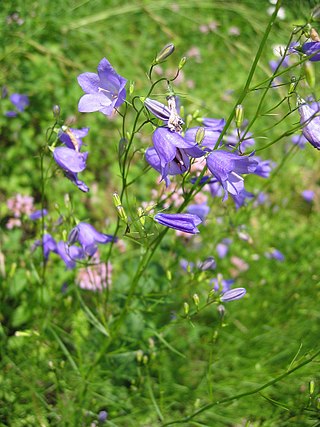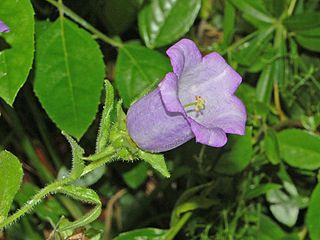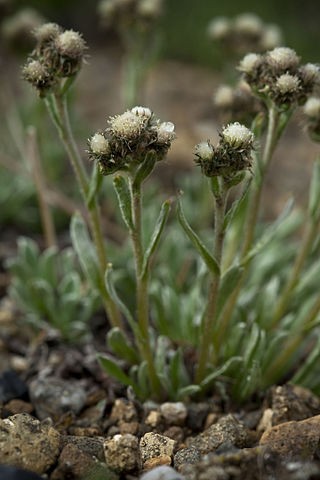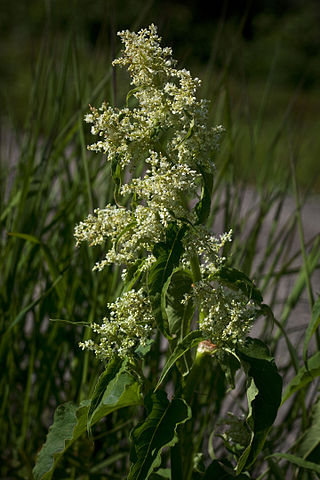
Campanula is the type genus of the Campanulaceae family of flowering plants. Campanula are commonly known as bellflowers and take both their common and scientific names from the bell-shaped flowers—campanula is Latin for "little bell".

The family Campanulaceae, of the order Asterales, contains nearly 2400 species in 84 genera of herbaceous plants, shrubs, and rarely small trees, often with milky sap. Among them are several familiar garden plants belonging to the genera Campanula (bellflower), Lobelia, and Platycodon (balloonflower). Campanula rapunculus and Codonopsis lanceolata are eaten as vegetables. Lobelia inflata, L. siphilitica and L. tupa and others have been used as medicinal plants. Campanula rapunculoides may be a troublesome weed, particularly in gardens, while Legousia spp. may occur in arable fields.

Campanula rotundifolia, the common harebell, Scottish bluebell, or bluebell of Scotland, is a species of flowering plant in the bellflower family Campanulaceae. This herbaceous perennial is found throughout the temperate regions of the northern hemisphere. In Scotland, it is often known simply as bluebell. It is the floral emblem of Sweden where it is known as small bluebell. It produces its violet-blue, bell-shaped flowers in late summer and autumn.

Campanula carpatica, the tussock bellflower or Carpathian harebell, is a species of flowering plant in the family Campanulaceae.

Campanula glomerata, known by the common names clustered bellflower or Dane's blood, is a species of flowering plant in the genus Campanula, belonging to the family Campanulaceae. It is the county flower of Rutland, England.

Campanula medium, common name Canterbury bells, is an annual or biennial flowering plant of the genus Campanula, belonging to the family Campanulaceae. In floriography, it represents gratitude, or faith and constancy.

Campanula rapunculoides, known by the common names creeping bellflower, rampion bellflower, rover bellflower, garden bluebell, creeping bluebell, purple bell, garden harebell, and creeping campanula, is a perennial herbaceous plant of the genus Campanula, belonging to the family Campanulaceae. Native to central and southern Europe and west Asia, in some parts of North America it is an extremely invasive species.

The Circumboreal Region in phytogeography is a floristic region within the Holarctic Kingdom in Eurasia and North America, as delineated by such geobotanists as Josias Braun-Blanquet and Armen Takhtajan.
Artemisia kruhsiana, also known as Alaskan sagebrush, Alaskan wormwood, and Siberian wormwood, is a species of plant in the sunflower family. It is found in Asia from eastern Siberia to the northern Russian Far East, and in North America from Alaska, British Columbia, Yukon, and the Northwest Territories.

Campanula scouleri is a species of bellflower known by the common names pale bellflower and Scouler's harebell. It is native to the mountains of western North America from northern California to Alaska.

Campanula cochleariifolia, common name earleaf bellflower or fairy's-thimble, is a species of flowering plant in the family Campanulaceae, native to the Pyrenees, Alps, French Massif Central, and Carpathian Mountains of Central Europe. It is a rhizomatous herbaceous perennial growing to 10 cm (4 in). Clumps of bright green leaves produce nodding pale blue bell flowers on wiry stalks. It is often found growing on limestone.
Alaskana is a Neo-Latin term meaning of Alaska, used in taxonomy to denote species indigenous to or strongly associated with Alaska.
Acer alaskense is an extinct maple species in the family Sapindaceae described from a fossil leaf. The species is solely known from the Latest Paleocene sediments exposed in the Matanuska River Valley, Matanuska-Susitna Borough, Alaska. It is the type species for the extinct section Alaskana.

Campanula lasiocarpa, also known as the mountain harebell or Alaska harebell, is a plant native to the northwestern portion of North America including the US states of Alaska and Washington, as well as the Canadian provinces of Alberta, British Columbia, the Northwest Territories, and the Yukon.

Antennaria friesiana, or Fries' pussytoes, is an Arctic species of plants in the family Asteraceae. It is the northern reaches of Asia and North America. Many of the populations lack male (staminate) flowers and reproduce asexually.

Koenigia alaskana is an Asian and North American species of flowering plant in the buckwheat family known by the common names Alaska wild-rhubarb and alpine knotweed.
Steineropsis is a genus of lichen-forming fungi in the family Pannariaceae. It has two species. The genus was circumscribed by Toby Spribille and Lucia Muggia in 2010, with Steineropsis alaskana assigned as the type species. The type specimen of this lichen was found in Skagway, Alaska, where it was growing on a rock in a snowbed at an altitude of 1,051 m (3,448 ft). The generic name alludes to a resemblance to the genus Steinera. A second species, Steineropsis laceratula, also found in Alaska, was added to the genus in 2020. Molecular phylogenetic analysis showed that Steineropsis has a sister taxon relationship to genus Protopannaria.
Ceratinella ornatula is a spider species native to the Canada, Greenland and the United States. It belongs to the family Linyphiidae. The species was first described by C. R. Crosby and S. C. Bishop in 1925 as Ceraticelus ornatulus.

Campanula petiolata is a flowering plant that is called western harebell when it is distinguished from Campanula rotundifolia or simply harebell when it is considered the same species. It is in the bellflower family (Campanulaceae). This herbaceous perennial is found in areas of western North America with continental climates. It produces violet-blue, bell-shaped flowers in late summer and autumn. It is closely related to Campanula rotundifolia and is considered either a subspecies or the same species by many botanists.















